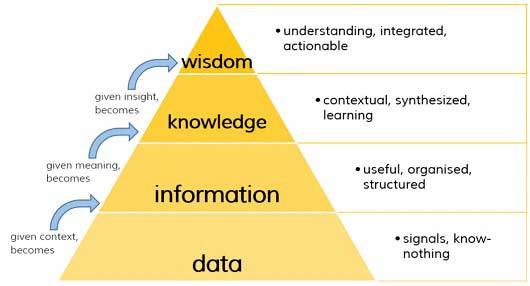Not all content is created equal. Or at least that’s what the Data-Information-Knowledge-Wisdom Hierarchy suggests.
It’s a theory with confusing origins, sometimes traced back to a 1934 poem by T.S. Eliot and further developed by Russell Lincoln Ackoff and Milan Zeleny in the 1980s. Because both everyone and no one seems to have a claim on this theory, it has also been called many names over the years: the DIKW hierarchy, the DIKW pyramid, or the DIKW chain. While it’s origins and names are murky, it is crystal clear that this is theory that can help us become better presenters.
The DIKW helps us avoid data dump presentations that can bore an audience to tears and move toward presentations that impart knowledge and wisdom. Presentations that create energy and momentum. This helpful graphic (albeit with British spellings) will give you a quick overview of the theory.

Data
As you can see in the graphic above, data is at the lowest level of the pyramid. It is the raw material that we use to begin communicating something. At this level, the content doesn’t mean much to the audience. It’s a list of numbers or words or symbols that are separated from context.
Too many presenters make the mistake of simply covering data. It’s okay to cover statistics or results, but not without connecting them via context, meaning, and insight. If we hang out on this lower level of the hierarchy in our presentation, our audience won’t understand how the data connects to anything or anyone. As a result, their interest and attention will wane.
Information
The way to move from data to information is to provide context. To do this, identify the relationships the data has by answering questions like who?, what?, when? and where? Another way to move from data to information is to communicate its relevance to the audience. Researcher Anthony Liew says, “Information is a message that contains relevant meaning, implication, or input for decision and/or action . . . In essence, the purpose of information is to aid in making decisions and/or solving problems or realizing an opportunity.”
When developing content for your presentation, don’t let yourself stray away from this guiding question: What does this mean for my audience? If you can answer that question for all of your content, you are moving in the right direction, up the hierarchy.
Knowledge/Wisdom
The top two levels of the pyramid are often combined because they are so intricately linked. Both are aimed at helping us make decisions and plan for the future. As Liew puts it, “The purpose of knowledge is to better our lives.” When data and information connect with, challenge, or change the audience’s prior experiences or education, it creates top-level content. Are you clearly communicating how your content will make your audience’s lives better?
Another way to achieve this top-level content is to think of the life of the data and information beyond the time of the presentation. How can this information continue on into the future? How will this data be used tomorrow? How can this content continue to speak when I stop speaking? When we create content with those questions in mind, the data and information that we present will sink in on a deeper level and will not soon be forgotten.
At Ethos3 we are passionate about teaching presentation methods based on solid research and time-tested theories, theories like the DIKW hierarchy. We don’t just know what to do, we know why it works. We’d love to help you make your next presentation great. Contact us now.